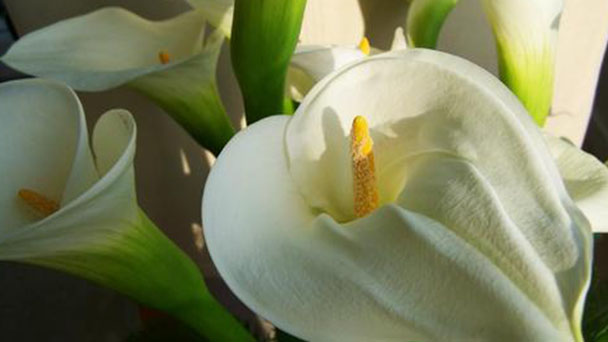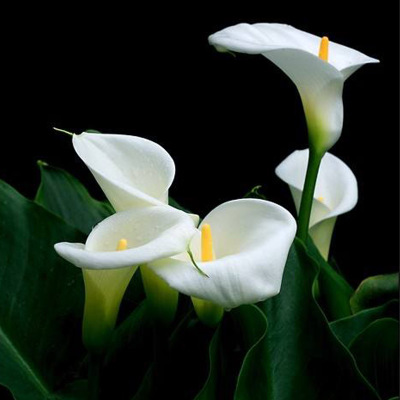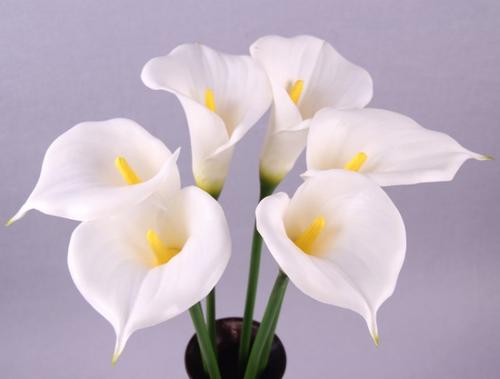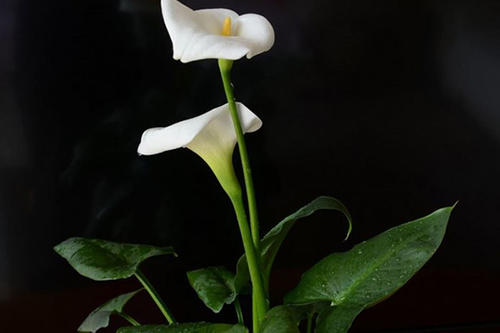Zantedeschia albo-maculata (spotted calla lily) profile
Written by Maggie
Sep 11 2021

Zantedeschia albo-maculata, commonly called spotted calla lily or white spotted arum, is a perennial herb of the genus calla in Araceae. Zantedeschia albo-maculata petiole is up to 100cm long, leaf blade long halberate, slightly drooping, green on both sides, spathe 10cm long, white, sometimes green, tube funnel-shaped than the eaves, deep purple at the base of the inner surface; Inflorescences of spikelets: berry oblate globose, green, fruiting August (kunming).
Zantedeschia Albo-Maculata is native to southern Africa. It is cultivated in Kunming. Zantedeschia albo-maculata likes a warm and humid environment, cultivation appropriate with fertile loose humus soil, adequate lighting requirements.
Zantedeschia albo-maculata is an excellent cut flower material, widely used in flower basket, wedding bouquet.
Zantedeschia albo-maculata picture

Morphological characteristics of Zantedeschia albo-maculata
Stems
Zantedeschia albo-maculata is a perennial herb with tubers.
Leaf
The petiole of Zantedeschia albo-maculata is 45 ~ 100 CMS, 1 ~ 2 CMS, 20 ~ 40 CMS, 7.5 ~ 10 CMS, slightly drooping, green on both sides with white patches, long halberd-shaped, thin heart arrow, narrow and sharp at the apex, thin side veins, most, the surface is slightly concave-shaped, the back is slightly raised. Buddha flame bud 10 CMS, white, sometimes green, tube is shorter than the eaves 1/2, oblique funnel-shaped, inside the base of the deep purple; Apex of eaves tapering to a tapered point.
Flowers
Zantedeschia albo-maculata is a spiked inflorescence: female 1.5-2cm long, 4-5 mm thick, male nearly as long as female, but slightly thinner. Ovary 4-5 locules, stigmas sessile, discoid.
Fruit
Zantedeschia albo-maculata berries are oblate, green, 1.3cm in diameter, with 1 to 2 seeds in each chamber.
Ecological habits of Zantedeschia albo-maculata
Zantedeschia albo-maculata is not only afraid of cold, but also of heat and high temperature. During the high temperature season, the aboveground part Withers, and the underground part of rhizome enters dormancy. Most calla lily is dormant during the low temperature in winter. Zantedeschia albo-maculata may flower annually if the temperature is suitable, but blooms profusely with bulbs replanted after dormancy. The flowering period of greenhouse cultivation in the north is from November to May of the following year.Cut flowers are water-resistant and ornamental for 15 to 20 days in winter and 7 to 10 days in summer.
How to grow and care for Zantedeschia albo-maculata
Soil
Deep turning: there are four steps to prepare the planting bed, namely deep turning the soil, disinfecting, making the bed and applying base fertilizer. First, turn the soil 20 ~ 30 cm deep.
Disinfection: the soil after the deep turn in the scorching sun exposure for a few days, or available steam, bitter chloride, methane bromide, pentachloronitrobenzene disinfection. The planting bed for Zantedeschia albo-maculata is usually tall with 80 cm wide and 40 cm wide for walks or 40 cm wide for walks. Higher than the ground 10㎝, higher than the path 20㎝ or so.Base fertilizer dosage is generally applied every 667㎡ greenhouse expanded chicken manure 400㎏, phosphoric acid Eucalyptus 50㎏; Or disinfection of decomposed farmyard fertilizer 2000 ~ 3000㎏, ammonium phosphate 50㎏.
Moisture
Zantedeschia albo-maculata likes to be wet, and in the vigorous growing season, it should be watered frequently to keep the soil moist. The air humidity in growing environment also wants tall, accordingly, all round the ground also should often spray water. But if the use of sprinkler irrigation, then spray wet foliage can prevent water accumulation in the leaf sheath, causing decay. After flowering, water should be reduced to promote dormancy.
Nutrition
At the early stage of Zantedeschia albo-maculata growth, the amount of topdressing should be less, such as fertile soil, without topdressing, but into the flowering period, to topdressing, inorganic fertilizer and organic fertilizer can be applied alternately. Inorganic fertilizer using nitrogen, phosphorus, potassium 1:1:1 ratio mixture, with 0.5% ~ 1% aqueous solution, with water irrigation, every 15d once, every 667㎡ greenhouse once chased into 10 ~ 15㎏, irrigated immediately with water rinse leaf surface and leaf base, so as not to fat water into the leaf scabbed caused by "burning seedlings". Organic fertilizer can be decomposed pig manure, chicken manure, etc., each plant below the root neck 5 CMS dug into the pit, each plant about 50g, the whole growth season can be applied organic fertilizer 2 ~ 3 times.T op dressing should be stopped after flowering period to promote dormancy.

The temperature
The spring-like temperature (12-25 ℃) all the year round can make calla lilies bloom annually. It is necessary to increase the temperature for Zantedeschia albo-maculata winter production in the north and lower the temperature for summer production in the south.
Light
When the sun is too strong in summer, it is necessary to shade the sun properly for Zantedeschia albo-maculata. The shading net with a shading rate of 30% ~ 50% can be generally used. Autumn and winter need more sufficient sunshine, do not need to shade. Cultivation in winter in the north, if additional light can be added, the growth and flowering are better. The effect of continuous light for 3 ~ 5h after the straw curtain is lowered in the afternoon is better.
Strip off old leaves
In the growth flowering flourishing period of Zantedeschia albo-maculata, if the leaf is too luxuriant crowded fully, should be timely stripped of the external already smoked the old leaf of the flower stem, cut off from the base, the purpose is to avoid the leaf too much influence light and ventilation, promote the growth of the flower stem, improve output. If old leaf of Zantedeschia albo-maculata is not much, but new leaf is too exuberant, interior is ventilated poor, flower stem is little, still can undertake pull a leaf processing, press leaf gently to all round, make plant cluster develops, such recombination reasonable water fertilizer measure, can raise produce a flower quantity.
Ventilation
The whole greenhouse must have good ventilation measures, such as solar greenhouse spring and autumn can be used before the foot or rear window ventilation, winter can be used at the top of the greenhouse ventilation, and the need for stronger convection ventilation measures in summer, otherwise the disease is serious, bad flowering.
The propagation of Zantedeschia albo-Maculata
Division
After the main flowering period or dormant period of Zantedeschia albo-maculata, dig out the tubers of the tubers of the tubers and divide one cluster into 2-3 clusters (each cluster should have 2-3 bud points) according to the size of the original tubers and the number of bud points. Plant them again, manage them normally, and they can blossom in 3 months.
The child ball propagation
Dig out the dormant tubers and cut off some smaller tubers of Zantedeschia albo-maculata after normal division. These small tubers need to be cultivated in the open ground for 1 to 2 years before they become flowering bulbs. Before freezing in autumn, prepare the ground to make a bed, and cultivate the daughter balls with common garden soil. The growth of the daughter balls is slow. If the culture substrate is used, most of the molecular balls can form flowering balls in that year.
Seed propagation
Zantedeschia albo-maculata can be sown and propagated, but because of the low natural seed setting rate, it is difficult to collect seeds. If sown and propagated, strong mother plant can be selected and artificially pollinated, and the seeds can be harvested after maturity. Zantedeschia albo-maculata was sown immediately after harvest, and the germination temperature was about 20℃. The buds were unearthed at about 4 weeks and transplanted with 2 ~ 3 true leaves. Under the condition of excellent cultivation and management, flowering ball can be cultivated in two years.
The distribution of Zantedeschia albo-Maculata
Zantedeschia albo-maculata is native to southern Africa and cultivated in Kunming.
Function of Zantedeschia Albo-Maculata
The Zantedeschia albo-maculata is a famous cut flower with long, soft stems and strange flowers. When making floral works, different methods are used to make products.

Latest Updated
- Benefits of Bugleweed - 7 Science-backed Health Benefits
- Bugleweed Dangers & Side Effects - Is It Poisonous?
- How to Plant Evergreen Trees - What You Should Know
- When to Plant Evergreens - Grow Guide for Evergreen Trees
- 12 Wonderful Evergreen Shrubs for Your Garden
- 12 Popular Evergreen Plants with Pictures for Beginners
- When And How To Prune A Lilac Bush Like a Pro
- How to Grow & Care for Lilac Vine (Hardenbergia Violacea)
- Japanese Lilac Tree (Syringa Reticulata) Care & Propagation Guide
- Shumard Oak Pros and Cons - What to Know
Popular Articles
- Winter maintenance of Antirrhinum Majus
- How to Grow Terminalia Mantaly Tree
- How to Grow and Care for Crossostephium Chinense
- How to grow Antirrhinum Majus in spring
- Peristeria Elata (Dove Orchid) Profile: Info & Care Guide
- Underwatered Snake Plant (Sansevieria Trifasciata) - Signs And How To Fix
- How to Care for Brazilian Jasmine Plant (Mandevilla Sanderi)
- How to Grow & Care for Graptopetalum Purple Delight in Summer
- Rosa Chinensis (China Rose): Plant Growing & Care Tips
- How to Care for Baby Sun Rose (Aptenia Cordifolia)